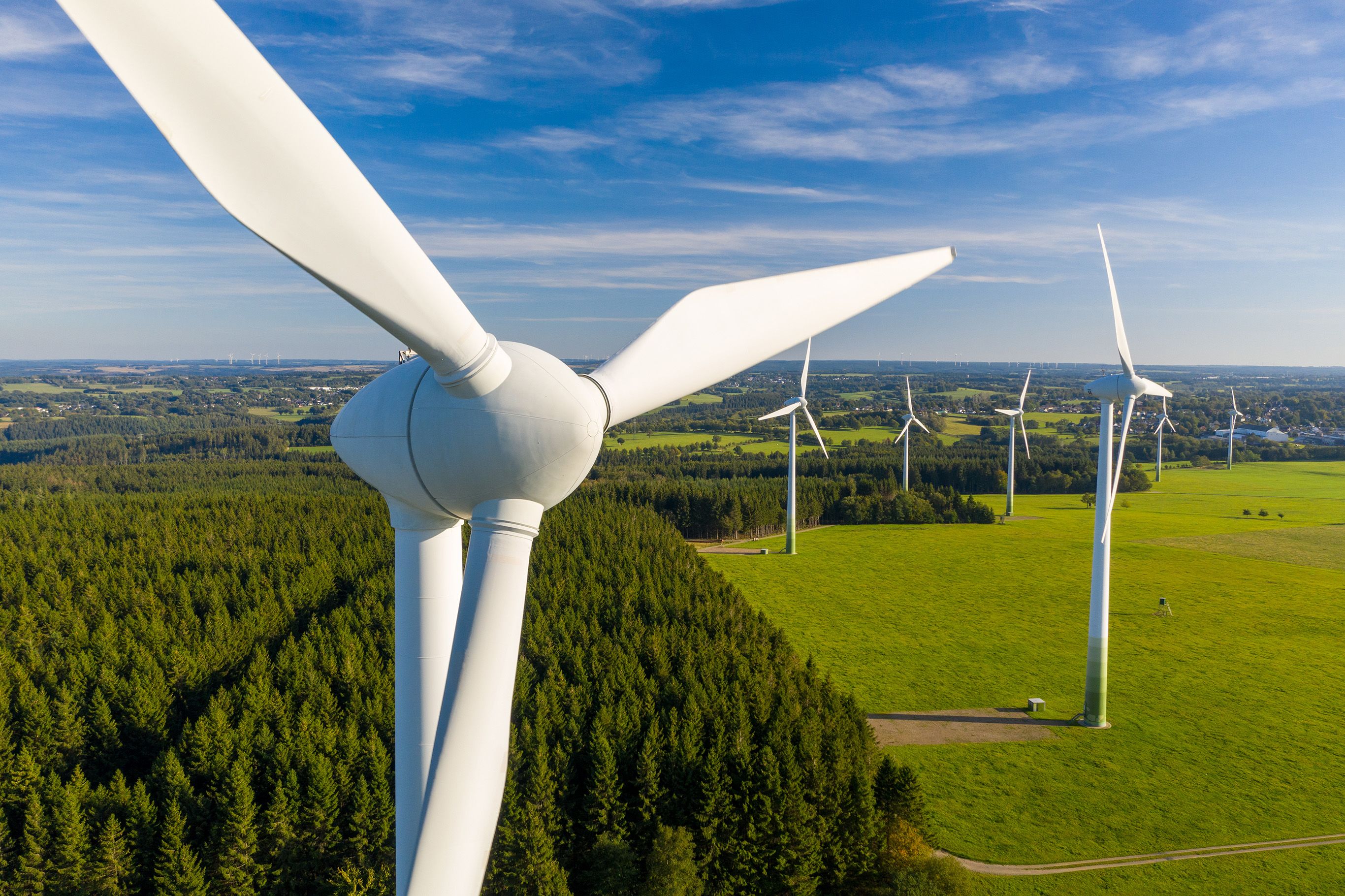The rise of the green collar workforce
Contributors:
Sailesh Hota
Practice Director, Everest Group
David Ingleson
Sector Managing Director for Energy, Engineering and Industrials, AMS
Alain Proietti
Global Head of Talent Acquisition, Siemens Energy


As businesses and nations move towards net zero carbon emissions, employers are looking for a new breed of employees to tackle the climate challenge by 2050: A green collar workforce.
There’s good news and tough news for talent acquisition leaders whose mission it is to find job candidates with the in-demand skills for the coming 25 years. First the challenging news: According to market research giant Deloitte, more than 800 million jobs are vulnerable to the impact of climate change and the push towards net zero carbon emissions.
The good news is that a new breed of employee is emerging with the help of higher education, upskilling and a sense of purpose to fill these new roles and solve this dire dilemma.
Meet the green collar worker. While technologists focus on the latest innovations of AI and machine learning, this category of jobs could save the planet. A mixture of hands-on and intellectual positions, green collar jobs can range from blue collar, labor-intensive roles such as recycling and green energy installations to white-collar roles such as designing energy efficient systems, consulting and drafting sustainable policies.
These new roles are in high demand at the moment and experts foresee a day when many traditional roles will have a critical green-collar component.
Further research by Deloitte explains that this new breed of worker will transform how large enterprises and small companies will do business in the coming quarter century.
“A typical green collar worker can be an office worker or a manual laborer. It is not about the industry, location, or skills of a worker that makes them green collar — it’s about how decarbonization does (or doesn’t) influence their work and their skills,” according to the authors of the 2024 Deloitte report entitled “Work Toward Net Zero.”
As for the men and women who will fill these new roles, Deloitte’s analysts predict various changes in training and career development in the coming years. “Some existing occupations will significantly transform, others may only need to change at the margins, and entirely new ones will emerge as the green collar workforce shapes the future of work,” according to Deloitte.
AMS has not only recognized the need for a green collar workforce, the TA and recruitment leader is helping many savvy companies — such as Hitachi Energy, GE Vernova and Siemens Energy — to achieve their net zero goals with a new team of highly skilled, trained and motivated workers.
Rather than just confining the definition of green collar jobs to roles that are directly linked to the environmental sector, AMS believes the new green collar workforce is much broader than this narrow definition, according to David Ingleson, Sector Managing Director for Energy, Engineering and Industrials for AMS.
“Green collar roles can sit within any industry and sector of the economy with the key common characteristic being that the core function of the role is directed towards the goal of more sustainable practices,” he says. “This means that while a Wind Turbine Technician for a renewable energy company is clearly a green collar worker, so is a Sustainable Finance Analyst in the investment banking sector.”
If nations are to meet their 2050 net zero commitments, forward-thinking TA leaders will need to fill the roles of this unique sector in short order. Not being prepared for the impact of climate change will not be an acceptable excuse. There is a desperate need for people with these skills, says Ingleson.


What a green collar workforce means for TA leaders
Although they are new to the hiring landscape, green collar positions are just like any other new and emerging roles, and in a dynamic and constantly changing global economy, the world has shown that it is more than capable of changing to the required needs, says Ingleson.
“AMS has seen similar challenges as we moved from analogue to digital technologies and from manual tasks to automated tasks and these challenges have all been overcome,” he says. “Admittedly, we still have skills deficits in critical areas like technology but the green collar workforce is arguably more accessible than highly technical disciplines like cybersecurity or data science.”
Ingleson adds that the green collar workforce is made up of a range of skills in what could also be categorized as blue, gray and white collar roles but that the focus is simply on making the world more sustainable.
“It is for this reason that hiring for these roles should not be as challenging as we think it might be,” he says.
This vision of the future is shared by the global research giant, Everest Group. Sailesh Hota, Practice Director, points out:
“Government data show the global renewables workforce reached 16.2 million in 2023, and under just-transition policies, the UN and ILO project another 24 million green-economy jobs by 2030”.
Hota goes on to stress that, “green-collar talent will underpin climate-resilient supply chains, zero-carbon microgrids, and advanced carbon management platforms. For TA leaders, the choice is stark: build integrated upskilling engines now to develop the workforce that will power and sustain enterprises of tomorrow, or risk seeing that future delivered by more agile competitors.”
That said, finding, nurturing and recruiting new talent to fill these green collar jobs may need extra care and attention at first. On the plus side, a new generation of young and highly-educated job candidates is entering the workforce from high schools and universities and this population has a passion for addressing the climate change challenge. On the downside, TA leaders report that newer candidates often seek more lucrative jobs in non-green sectors such as tech and finance for their first choice of careers.
“Generation Z and Alpha are highly motivated to embark on careers with purpose, although the sectors in which green collar roles are more prevalent — the more traditional ‘green’ economy which is focused on the Energy, Engineering, Industrials and Utilities sectors — are at present deemed less attractive than the digital, technology and financial sectors,” says Ingleson. “Although green collar roles sit within these sectors, this leads us to a point where the emerging talent is in the main, being attracted to roles sitting outside the green collar workforce, despite these lofty aspirations around ‘purpose.’”
Notwithstanding this challenge, TA leaders should not lose sight of the benefits of hiring green collar workers. Ingleson says that this reality should be “a call to action” to all organizations in all sectors with a strong narrative on sustainability to tell their story in a compelling way.
“There’s plenty of potential in these jobs to be a part of change,” he says. “We need to sell that especially in our campus and early career recruiting efforts.”


A green collar upskilling opportunity
Green collar jobs are not just about young graduates and new workers entering the workforce for the first time; experienced employees with years on the job will benefit from this emerging job category.
“The climate crisis is upon us, and it will take all generations of talent to steer the planet towards a safer path,” says Ingleson. This means that more mature and experienced workers need to look at re-skilling and up-skilling opportunities either offered by their organizations as part of internal learning and development programs or simply learning on the job and using the transferable skills they may possess, he adds.
Innovative organizations such as Hitachi Energy and GE Vernova are investing heavily in green skills training as this is where they see their drivers for future growth, and both organizations offer these services to their customers as well, says Ingleson. Meanwhile, the more traditional academic and vocational training is growing at a fast pace with more academic institutions offering courses aligned to sustainability, and many large scale government schemes such as the EU’s Green Skills Initiative (one of several programs under the EU Green Deal) and India’s Green Skill Development Program (run by the Ministry of Environment, Forest and Climate Change) are up and running to support in the development of green skills.
“Demands aren’t necessarily explicit from clients, unless their core business is 100% aligned to the green economy such as a renewable energy company,” says Ingleson. However, the expectation that candidates have at the very least an appreciation and awareness of the importance of sustainability is becoming increasingly clear.
“As a result, AMS now offers sustainability courses as part of our recruit train and deploy offering, and we are increasingly expected to prove our own sustainability credentials as part of any procurement processes for new business as an increasing percentage of organizations have made significant sustainability-related commitments,” says Ingleson. For example, in 2021 around 60% of FTSE 100 companies were publicly committed to achieving net-zero by 2050, and this number now stands at more than 80%.
According to the Deloitte Economics Institute, an estimated 80% of the skills required to achieve net-zero emissions by 2050 already exist in today’s workforce. “This means most current workers are likely to only require upskilling — such as on-the-job training — rather than complete retraining to remain in their current job or to gain a new job due to decarbonization. The skills of workers can facilitate equitable employment opportunities as economies decarbonize,” says Deloitte.
One such AMS client that is achieving some success in its green collar journey is Siemens Energy. The energy giant prides itself on the big steps it has taken to add green collar workers to its ranks of dedicated employees.
“As a global leader in energy technology, we are at the forefront of reducing carbon emissions across the energy landscape, from conventional to renewable power,” says Alain Proietti, Global Head of Talent Acquisition for Siemens Energy. “What this means is that many of our people, require what could be categorised as ‘green’ skills, and a significant proportion of the EUR 80m we invested in continuing education in FY24 was aligned to this purpose — to upskill and re-skill our employees to enable our mission to reduce emissions”.
Siemens Energy is doubling down on green collar jobs. “A large proportion of new hires to Siemens Energy will be expected to bring existing green skills with them, or be excited about the prospect of developing them,” says Proietti.
Reducing carbon emissions and providing energy-efficient products and services is a critical mission for the benefit of everyone on the planet. Thankfully, AMS can help forward-thinking and responsible organizations to fill their ranks with green collar jobs in the years to come.

A green collar upskilling opportunity
Green collar jobs are not just about young graduates and new workers entering the workforce for the first time; experienced employees with years on the job will benefit from this emerging job category.
“The climate crisis is upon us, and it will take all generations of talent to steer the planet towards a safer path,” says Ingleson. This means that more mature and experienced workers need to look at re-skilling and up-skilling opportunities either offered by their organizations as part of internal learning and development programs or simply learning on the job and using the transferable skills they may possess, he adds.
Innovative organizations such as Hitachi Energy and GE Vernova are investing heavily in green skills training as this is where they see their drivers for future growth, and both organizations offer these services to their customers as well, says Ingleson. Meanwhile, the more traditional academic and vocational training is growing at a fast pace with more academic institutions offering courses aligned to sustainability, and many large scale government schemes such as the EU’s Green Skills Initiative (one of several programs under the EU Green Deal) and India’s Green Skill Development Program (run by the Ministry of Environment, Forest and Climate Change) are up and running to support in the development of green skills.
“Demands aren’t necessarily explicit from clients, unless their core business is 100% aligned to the green economy such as a renewable energy company,” says Ingleson. However, the expectation that candidates have at the very least an appreciation and awareness of the importance of sustainability is becoming increasingly clear.
“As a result, AMS now offers sustainability courses as part of our recruit train and deploy offering, and we are increasingly expected to prove our own sustainability credentials as part of any procurement processes for new business as an increasing percentage of organizations have made significant sustainability-related commitments,” says Ingleson. For example, in 2021 around 60% of FTSE 100 companies were publicly committed to achieving net-zero by 2050, and this number now stands at more than 80%.
According to the Deloitte Economics Institute, an estimated 80% of the skills required to achieve net-zero emissions by 2050 already exist in today’s workforce. “This means most current workers are likely to only require upskilling — such as on-the-job training — rather than complete retraining to remain in their current job or to gain a new job due to decarbonization. The skills of workers can facilitate equitable employment opportunities as economies decarbonize,” says Deloitte.
One such AMS client that is achieving some success in its green collar journey is Siemens Energy. The energy giant prides itself on the big steps it has taken to add green collar workers to its ranks of dedicated employees.
“As a global leader in energy technology, we are at the forefront of reducing carbon emissions across the energy landscape, from conventional to renewable power,” says Alain Proietti, Global Head of Talent Acquisition for Siemens Energy. “What this means is that many of our people, require what could be categorised as ‘green’ skills, and a significant proportion of the EUR 80m we invested in continuing education in FY24 was aligned to this purpose — to upskill and re-skill our employees to enable our mission to reduce emissions”.
Siemens Energy is doubling down on green collar jobs. “A large proportion of new hires to Siemens Energy will be expected to bring existing green skills with them, or be excited about the prospect of developing them,” says Proietti.
Reducing carbon emissions and providing energy-efficient products and services is a critical mission for the benefit of everyone on the planet. Thankfully, AMS can help forward-thinking and responsible organizations to fill their ranks with green collar jobs in the years to come.
For more information, book a consultation with an AMS green collar thought leader today.

written by Phil Albinus in partnership with the Catalyst Editorial Board
with contribution from:
Sailesh Hota
Practice Director
Everest Group
David Ingleson
Sector Managing
Director for Energy, Engineering and Industrials, AMS
Alain Proietti
Global Head of Talent Acquisition
Siemens Energy





